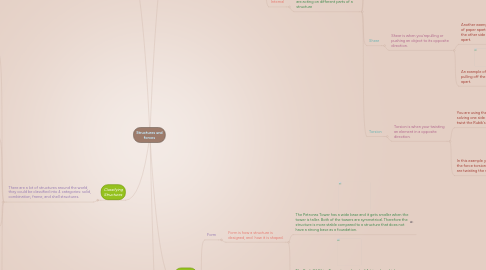
1. Center of Gravity
1.1. The center of gravity is where the most mass of an object is on. or where gravity seems to act on the most.The lower the center of gravity is the more stable a structure is.
1.1.1. As you could see above the center of gravity is on the left side of the see saw, because most of the mass is putted on the left side of the see saw.
1.1.2. If your doing a cartwheel, the center of gravity would be on your head, because when your doing a cartwheel your basically transferring your weight upwards. So that;s why the center of gravity would be on your head.
2. Classifying Structures
2.1. There are a lot of structures around the world, they could be classified into 4 categories: solid, combination, frame, and shell structures.
2.1.1. Shell
2.1.1.1. Shell structures are made out of hollow materials that could protect another element.
2.1.1.1.1. A turtles shell is a shell structure because it helps protect the turtle inside. The shell is strong and it is hollow on the inside.
2.1.1.1.2. Sydney Opera House is a shell structure, it is made out of ceramic tiles that interlock with each other. It covers the top of the shell structure and protects the people on the inside.
2.1.2. Frame
2.1.2.1. Frame structures are made out of different materials tighten together.
2.1.2.1.1. The Eiffel tower is a frame structure, it is made out of wrought iron lattice fasten together.
2.1.2.1.2. Leaves are frame structures because of the veins that form a frame for the leaves.
2.1.3. Solid
2.1.3.1. A solid structure is a structure made out of hard, and sturdy materials. It is not hollow on the inside and is very strong.
2.1.3.1.1. Solid structures could be made naturally. The example that you see up here is a rock. This is a solid because it is made out of firm materials like sediments.
2.1.3.1.2. The ice cubes are man-made solid structure, it is made out of water that has been frozen. The coldness solidifies, and hardens the water into an ice cube. The purpose of the ice cube is to cool down drinks.
2.1.4. Combination
2.1.4.1. Combination structures are combined with shell, frame and solid. Usually combination structures have a solid foundation.
2.1.4.1.1. A ant hole is a combination structure because it is combined with a frame and a solid structure. The frame structure would be the inside of the ant hole where all the passages are. The outside of the ant hole would be a solid because it is strong enough to sustain the ants weight.
2.1.4.1.2. Running shoes could be an example of a combination structure because it is combined with solid, shell, and frame. The solid part of the running shoe would be the sole of the shoe, frame as the side of the shoe that goes around the foot, and shell as the layer that helps protect our foot.
3. Forces
3.1. A force is a pull or a push caused by anything in our world.
3.1.1. External
3.1.1.1. External forces acts on a structure from the outside. A force that is a external force would be gravity. Gravity is the force that pulls everything and everyone down on earth.
3.1.1.1.1. Magnitude
3.1.2. Internal
3.1.2.1. A internal force is when two forces are acting on different parts of a structure
3.1.2.1.1. Compression
3.1.2.1.2. Tension
3.1.2.1.3. Shear
3.1.2.1.4. Torsion
4. Form and Functions
4.1. Form
4.1.1. Form is how a structure is designed, and how it is shaped.
4.1.1.1. The Petronas Tower has a wide base and it gets smaller when the tower is taller. Both of the towers are symmetrical. Therefore the structure is more stable compared to a structure that does not have a strong base as a foundation.
4.1.1.2. The Bank Of China Tower is made out of 4 triangles which forms a square base interlocking with each other. The base would be stable and it can most likely withstand dynamic loads.
4.2. Function
4.2.1. Function is how a structure is used. If the structure is man-made, the purpose of making the structure depends on how it is used.
4.2.1.1. Every man-made structure has a function. This structure is built to make travelling easier so you could save time to get from one place to another.
4.2.1.2. The function of a binder is to hold papers so they will not be scattered all over the place and it helps you organize your work.
5. Loads
5.1. A load is a push or a pull (Force) acting on a object.
5.1.1. Dead Loads
5.1.1.1. A dead is the structure structure itself. The force acting on a dead load is gravity. All dead loads are the structure itself.
5.1.1.1.1. The chair you see above is a dead load, the only force acting on it is gravity itself.
5.1.1.1.2. A basement is a dead load, even tough it is part of a house it is still considered to be a dead load because it is built with it.
5.1.2. Live Loads
5.1.2.1. A live load is when a temperate weight gets applied to the to a structure.
5.1.2.1.1. Even though your house is build with blind, it is not a live load, it could be easily removed and replaced with curtains.
5.1.2.1.2. A tent could be a live load because, your just setting it up in a forest, it could be removed.
5.1.3. Dynamic Loads
5.1.3.1. A dynamic load is neither a live load and a dead load, it happens when a force is effecting a structure from the outside of it.
5.1.3.1.1. Someone pushing a chair is a dynamic load, because your pushing the structure, causing it to move from the outside of the structure.
5.1.3.1.2. Another dynamic load could be when your pushing your desk, because your moving seats with someone. This is a dynamic load because your applying forces from the outside.

